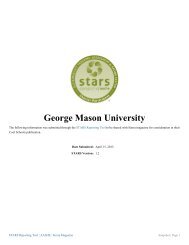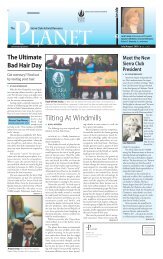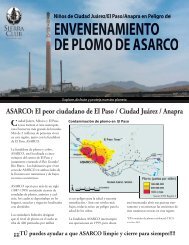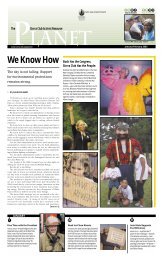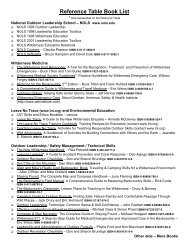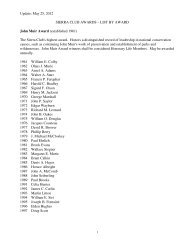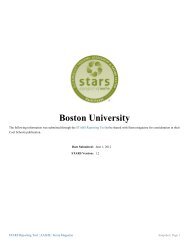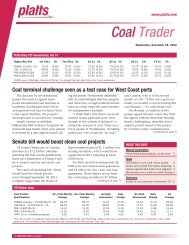Lost, A Desert River and its Native Fishes - Sierra Club
Lost, A Desert River and its Native Fishes - Sierra Club
Lost, A Desert River and its Native Fishes - Sierra Club
Create successful ePaper yourself
Turn your PDF publications into a flip-book with our unique Google optimized e-Paper software.
MUELLER AND MARSH 7<br />
Fig. 7. The lower river was typically bordered with cottonwood <strong>and</strong> willow trees. Courtesy of the Arizona Historical<br />
Society, Yuma.<br />
over...The trees, sixty feet high, resembled a field<br />
of gigantic grass or unripened grain; the river was<br />
the reaper cutting it away at the roots...“<br />
Kolb (1927) had to portage over Laguna Dam which<br />
had been constructed in 1909 as the first manmade diversion<br />
to span the entire river. His journal continued: —In<br />
another place there were no banks, <strong>and</strong> the water had<br />
spread for three miles in broken sloughs <strong>and</strong> around halfsubmerged<br />
isl<strong>and</strong>s, the one deep channel being lost in<br />
the maze of shallow ones...Once I lost my way <strong>and</strong> spent<br />
a half hour in getting back to the right channel [Kolb,<br />
1927].“<br />
Joseph Grinnell, a professor of zoology from the<br />
University of California, conducted bird <strong>and</strong> mammal<br />
surveys between Needles <strong>and</strong> Yuma in 1910 (Grinnell,<br />
1914). During his trip, he collected a few fish <strong>and</strong> made<br />
some interesting observations concerning drought. His<br />
report provided an excellent description of the river <strong>and</strong><br />
<strong>its</strong> biota.<br />
—The effects of the extraordinary <strong>and</strong> continuous<br />
load of sediment of the Colorado <strong>River</strong>,<br />
together with the inconstancy of <strong>its</strong> channel,<br />
doubtless accounts directly or indirectly for<br />
many of the peculiarities of the fauna...the<br />
Needles-to-Yuma section of the river valley there<br />
are no aquatic molluscs or decapod crustaceans,<br />
or tailed amphibians...“<br />
—The fish fauna in the main stream is sparse in<br />
both species <strong>and</strong> individuals. Our party seined at<br />
three different points in the main stream. At two of<br />
these nothing was caught; in the third, a<br />
backwater slough on the Arizona side above<br />
Mellen, four sorts of fishes were taken, [nonnative]<br />
catfish, bonytail, humpback sucker, <strong>and</strong><br />
[nonnative] carp. A huge minnow, called locally<br />
Colorado salmon, was caught with hook <strong>and</strong> line<br />
in backwater on the California side opposite<br />
Cibola, <strong>and</strong> was plentiful immediately below the<br />
Laguna Dam, where many were being taken by the<br />
Indians living near there.“<br />
—...there is relatively little cyptogamic aquatic<br />
flora in the Colorado <strong>River</strong>. There is therefore little<br />
or no food-supply from this source to attract<br />
plant-eating ducks...On the other h<strong>and</strong>, herons<br />
were notably plentiful because of the supply of<br />
catfish <strong>and</strong> carp made abundant at intervals by the<br />
drying-up of overflow ponds. While fishes were<br />
not abundant in the main stream, they were<br />
plentiful in the backwater sloughs, where, too, the<br />
water was more nearly clear because the sediment<br />
had a chance to settle out.“<br />
Aldo Leopold, who many consider the father of<br />
environmental conservation, dedicated a section (Green<br />
Lagoons) of his book, A S<strong>and</strong> County Almanac, to a canoe<br />
trip he took with his brother through the delta in 1922. He<br />
described the pristine area <strong>and</strong> added his unique<br />
perspectives to the value of this ecosystem.<br />
—It is part of the wisdom never to revisit a<br />
wilderness, for the more golden the lily, the more<br />
certain that someone has gilded it. To return not<br />
only spoils a trip, but tarnishes a memory. It is<br />
only in the mind that shining adventure remains<br />
forever bright. For this reason, I have never gone<br />
back to the Delta of the Colorado since my brother<br />
<strong>and</strong> I explored it, by canoe, in 1922... On the map<br />
the Delta was bisected by the river, but in fact the<br />
river was nowhere <strong>and</strong> everywhere, for he could<br />
not decide which of a hundred green lagoons<br />
offered the most pleasant <strong>and</strong> least speedy path to<br />
the Gulf. The still waters were of a deep emerald<br />
hue, colored by algae, I suppose, but no less<br />
green for all that. A verdant wall of mesquite <strong>and</strong><br />
willow separated the channel from the thorny<br />
desert beyond...Camp-keeping in the Delta was



